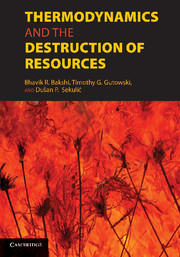Book contents
- Frontmatter
- Contents
- Contributor List
- Foreword by Herman E. Daly
- Foreword by Jan Szargut
- Preface
- Introduction
- PART I FOUNDATIONS
- PART II PRODUCTS AND PROCESSES
- PART III LIFE-CYCLE ASSESSMENTS AND METRICS
- PART IV ECONOMIC SYSTEMS, SOCIAL SYSTEMS, INDUSTRIAL SYSTEMS, AND ECOSYSTEMS
- Appendix: Standard Chemical Exergy
- Index
Foreword by Herman E. Daly
Published online by Cambridge University Press: 01 June 2011
- Frontmatter
- Contents
- Contributor List
- Foreword by Herman E. Daly
- Foreword by Jan Szargut
- Preface
- Introduction
- PART I FOUNDATIONS
- PART II PRODUCTS AND PROCESSES
- PART III LIFE-CYCLE ASSESSMENTS AND METRICS
- PART IV ECONOMIC SYSTEMS, SOCIAL SYSTEMS, INDUSTRIAL SYSTEMS, AND ECOSYSTEMS
- Appendix: Standard Chemical Exergy
- Index
Summary
The first and second laws of thermodynamics should also be called the first and second laws of economics. Why? Because without them there would be no scarcity, and without scarcity, no economics. Consider the first law: if we could create useful energy as it got in our way, we would have superabundant sources and sinks, no depletion, no pollution, and more of everything we wanted without having to find a place for stuff we didn't want. The first law rules out this direct abolition of scarcity. But consider the second law: even without creation and destruction of matter-energy, we might indirectly abolish scarcity if only we could use the same matter-energy over and over again for the same purposes: perfect recycling. But the second law rules that out. So it is that scarcity and economics have deep roots in the physical world, as well as deep psychic roots in our wants and desires.
Economists have paid much attention to the psychic roots of value, but not so much to the physical roots. Generally they have assumed that the biophysical world is so large relative to its economic subsystem that the physical constraints (the laws of thermodynamics) are not binding. But they are always binding to some degree and become very limiting as the scale of the economy becomes large relative to the containing biophysical system.
- Type
- Chapter
- Information
- Thermodynamics and the Destruction of Resources , pp. xv - xviPublisher: Cambridge University PressPrint publication year: 2011



